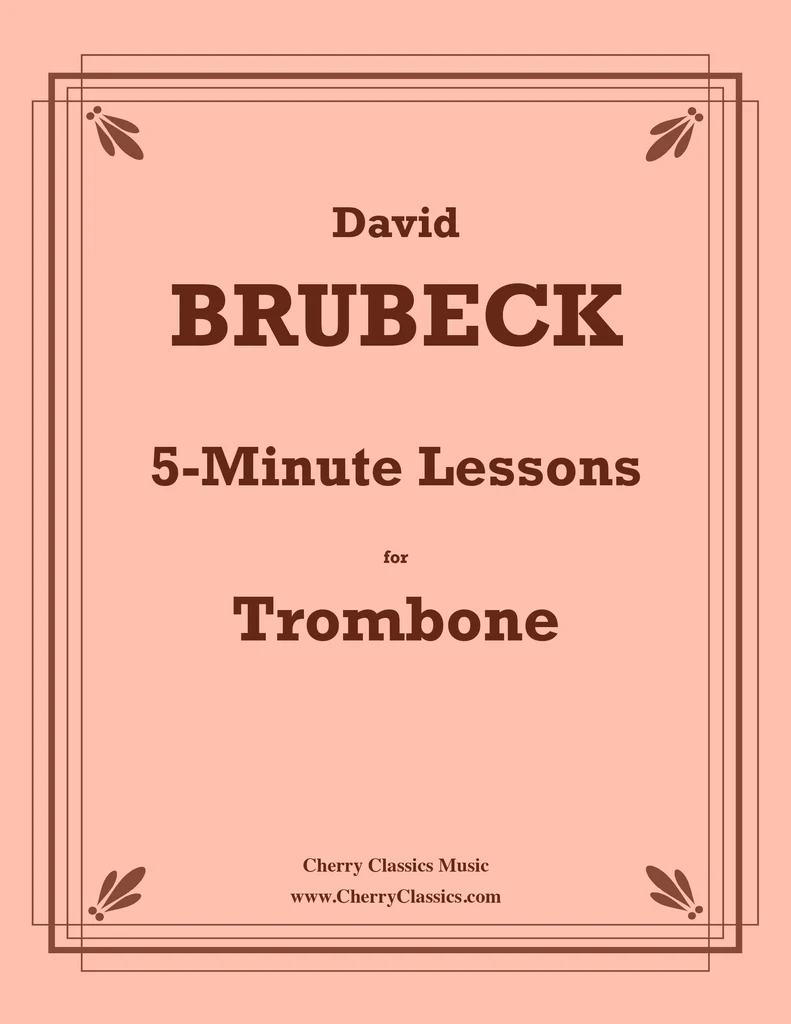5-minute Lessons for Trombone???
GOOD NEWS! THEY’RE BACK!!!! AND THEY ARE REVOLUTIONARY!!!! (REALLY! SEE BELOW!)
Gordon Cherry has them HERE!
You can have them, too! Enjoy…..

REVOLUTIONARY, YOU SAY? YES!
Brubeck served as Chief Educational Officer for one of the two major plastic trombone companies for a number of years and developed his 5-Minute Lessons for Trombone and his 5-Minute Lessons for Trumpet to START FROM ZERO, and allow VERY YOUNG musicians to play these much lighter plastic instruments. While another line of plastic trombone pedagogy settled Alto Trombones, 5-Minute Lessons uses traditional Bb Tenor Trombones BUT RESTRICTS THE POSITION USE TO THE FIRST FOUR POSITIONS! These are the positions reachable by “short arms”.
THE LESSONS START ON THE IDEAL NOTE FOR EASE OF PLAYING AND PROPER EMBOUCHURE DEVELOPMENT.
Based on his studies and analysis of the works of Arnold Jacobs and Shinichi Suzuki, this book also draws upon Brubeck’s experience as a published composer and jazz musician. Rarely does an advanced musician concern themselves with beginner materials in such a thorough and fresh manner.
Tired of boring rhythms and “school music”? These methods were presented before the 40th International Trumpet Festival in Columbus, Ohio and contain original compositions with lyrics; compelling rhythms; buzzing, breathing and singing techniques associated with the Chicago School of brass-playing as well as embouchure formation associated with the East-Coast Schools. Brubeck has taught trombone for more than 40 years and conducted youth orchestras for more than 35. This method balances the best of classical pedagogy with fresh American rhythms and approaches. Enjoy!
26 POPPING-FRESH PAGES INCLUDE:
Prelude A: Breathing, Relaxing & Re-Relaxing With a Steady Tempo
Prelude B: Mouthpiece Placement, Embouchure Formation & Buzzing
Prelude C: Posture, Slide Motion, Articulation, Assembling & Holding the Instrument
Lessons Nos. 1-4: Simple melodies in the range of a Major Second, then a Minor Third and lastly a Major Third; Focusing on Positions 1-4
Songs for Short Arms I: Original Compositions To Play & With Words to Sing! Sliding and Gliding, Keep That Slide Smooth & Lips Have got to rest
Lesson No. 5: Melodies up to a Perfect Fourth, focusing on glissandos
Prelude D: Counting and clapping rhythms comprised of half-notes, quarter-notes and eighth-notes
Sight-reading for Short Arms: Four, Short Passages : Yellow, Blue, Red & Green, using mostly quarter-notes and half-notes in the range of a Major Second and a minor third. Intended to be sight-read in the lessons without prior preparation.
Lessons Nos. 6 & 7: Range increases to an Augmented Fourth with a focus on articulation exercises and the introduction of eighth notes to play.
Rhythms for Short Arms: Blues, Rock & Pop Rhythms in compelling melodic pitch sets for young people.
Songs for Short Arms II: Focuses on accents, longer melodies and pick up notes-(anacruses).
Lesson No. 8: Melodies with a emphasis on glissando, and with increased range to a minor sixth. This includes approaching higher notes through glissando and familiar music transposed to a new key.
Prelude E: Targets on warm-ups by using positions 1-4 on two partials with glissandos.
Prelude F: Basic clapping and counting in 6-8 meter in addition to more difficult counting and clapping in 4-4 meter with 16th notes.
Rhythms for Short Arms B: Melodies featuring shuffle rhythms in 6-8, and lightly swung rhythms in 4-4 with some repetitive syncopation.
Rhythms for Short Arms C: More advanced melodies featuring shuffle rhythms in 6-8, and lightly swung rhythms in 4-4 with syncopation as well as Blues songs.
Lesson No. 9: Natural slurs, rounds, more difficult melodies in 6-8 and 3-4. Range increases to a minor seventh.
Rhythms for Short Arms D: Pop-Rock ground bass variations, and a bass-line type melody.
Lesson No. 10: Popular melodies with a range up to a Perfect Octave. Active breathing exercises, articulation patterns and another warm-up table in three partials of 1-4 positions.
Scales for Short Arms: Three-Note, Four-Note, Five-Note and Eight-Note Scales in Major, minor, Major Pentatonic and minor Pentatonic.
c. 2025 David William Brubeck. All Rights Reserved
